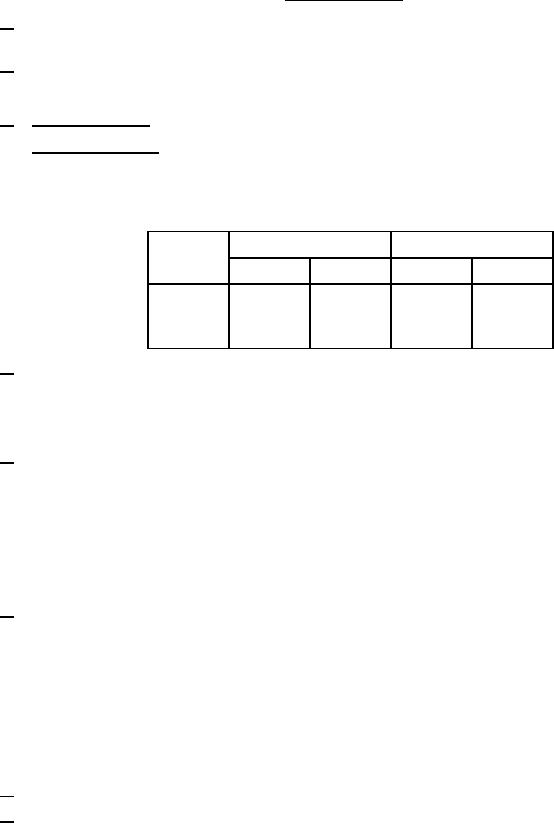
MIL-PRF-1/1726B
TABLE I. Testing and inspection - Continued.
10/
Other tube contact configurations may be used provided the tube contact area remains unchanged and the socket, jig, or cavity
gives equal performance. Mounting of the socket, jig, or cavity may be at the option of the manufacturer.
11/
Test to be conducted in power amplifier cavity as shown on Fidelitone Microwave, Inc., Drawing JVM D9819, or equivalent.
Driving power is defined as the new power delivered to the amplifier cavity input terminals and the reflected power shall be
subtracted from the incident power to obtain the net driving power. The output tuning shall be adjusted for maximum power output.
Test in cavity in accordance with Drawing 278-JAN. Cavity shall resonant at 1,354 r2.0 MHz with
Grid-anode resonance:
12/
tuning slug in accordance with Drawing 277-JAN at TA = +25 r5qC.
Test in cavity in accordance with Drawing 283-JAN. Cavity shall resonant at 1,719 r2.0 MHz with
Grid-cathode resonance:
tuning slug in accordance with Drawing 277-JAN at TA = +25 r5qC.
When plotted on graphs of resonant frequency versus grid-anode capacitance and resonant frequency versus grid-cathode
capacitance, the tube under test shall be represented by a point within the parallelogram whose four corners are located by the
following points:
Points
Capacitance (pF)
Frequency (MHz)
Cgp
Cgk
Fgp
Fgk
1
1.5
7.0
2,115
1,765
2
1.5
7.0
2,145
1,795
3
1.8
9.0
2,040
1,725
4
1.8
9.0
2,070
1,755
13/
This test shall be performed during the initial production and once each succeeding 12-calendar months in which there is
production. A regular double sampling plan shall be used, with the first sample of three tubes with an acceptance number of zero,
and a second sample of three tubes with a combined acceptance number of one. In the event of failure, the test will be made as a
part of conformance inspection, part 2, code level D, with an acceptance level of 6.5. The regular "12-calendar month" double
sampling plan shall be reinstated after three consecutive samples have been accepted. None of the testing shall be considered
as destructive, except in case of failure.
14/
The tube shall be mounted in a socket in accordance with Drawing 276-JAN and vibrated with simple harmonic motion. The peak
acceleration over the frequency range shall be within r20 percent of reference acceleration at 100 Hz. The frequency shall vary
from 55 to 500 Hz and return to 55 Hz with approximately logarithmic progression and shall require 4 minutes minimum, 6 minutes
maximum to traverse the range. Each tube shall be vibrated for 30 minutes in each axis X and Z, except that if the cumulative
results of tests on 50 or more tubes of a construction show that more than 75 percent of the tubes have higher output voltages in
one position, subsequent measurements need to be taken only in the position giving the higher readings. The voltages specified
herein shall be applied to the tube during vibration. The value of the alternating voltage, Ep, produced across the resistor, Rp, as
a result of vibration, shall be measured with a suitable device. This device shall have an appropriate voltage range, and shall have
the ability to measure, with an error of less than 10 percent, the rms value of a sine wave of voltage at all frequencies from 20 to
20,000 Hz. The value of the vibrational output, Ep, shall not exceed the limit specified herein at any point in the sweep-frequency
range during the last complete cycle of the cycling vibration.
15/
The torque test shall be performed as follows:
a.
The tube shall be held securely at the cathode connection. A force of 5 pounds shall be applied to the heater cup without
perceptible shock. This test may be made by applying the force at right angles to the inside of the cup at a point 0.109 inch
(2.77 mm) r.0.016 inch (0.41 mm) from the cathode end of the tube. An approved equivalent method may be used. The
heater cup shall not loosen or short circuit to the cathode connection.
b.
A torque of 15-inch pounds shall be applied between anode and cathode without shock.
c.
A torque of 40-inch pounds shall be applied between anode and grid without shock.
d.
A torque of 30-inch pounds shall be applied, both clockwise and counter-clockwise, between the anode cooler and the anode
contact surface, with no resulting loosening of the cooler or damage to the tube.
16/
Test in jig made in accordance with Drawing 280-JAN.
17/
Voltage to be 60 Hz ac applied between the anode and grid. No other voltages shall be applied. There shall be no evidence of
failure as indicated by arc-over.
4
For Parts Inquires call Parts Hangar, Inc (727) 493-0744
© Copyright 2015 Integrated Publishing, Inc.
A Service Disabled Veteran Owned Small Business